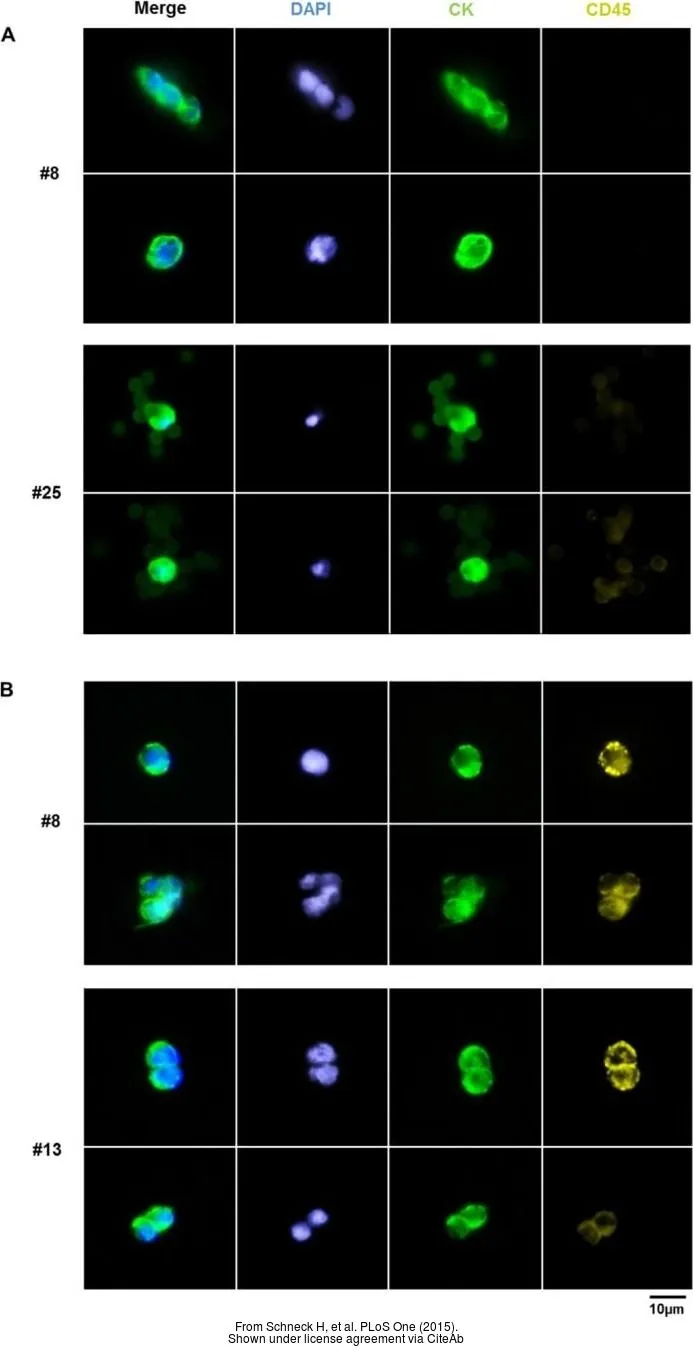
The data was published in the journal PLoS One in 2015.PMID: 26695635
pan Cytokeratin antibody [C-11] (FITC)
GTX11212
ApplicationsFlow Cytometry, ImmunoFluorescence, Western Blot, ImmunoCytoChemistry, ImmunoHistoChemistry, ImmunoHistoChemistry Paraffin
Product group Antibodies
ReactivityAmphibian, Bovine, Human, Mammals, Mouse, Rat
Overview
- SupplierGeneTex
- Product Namepan Cytokeratin antibody [C-11] (FITC)
- Delivery Days Customer9
- Antibody SpecificityThis antibody reacts with Cytokeratin peptides 4, 5, 6, 8, 10, 13, 18.
- Application Supplier NoteICC/IF: 1:50. IHC-P: 1:50. *Optimal dilutions/concentrations should be determined by the researcher.Not tested in other applications.
- ApplicationsFlow Cytometry, ImmunoFluorescence, Western Blot, ImmunoCytoChemistry, ImmunoHistoChemistry, ImmunoHistoChemistry Paraffin
- CertificationResearch Use Only
- ClonalityMonoclonal
- Clone IDC-11
- ConjugateFITC
- HostMouse
- IsotypeIgG1
- Scientific DescriptionGT211212 is a broad spectrum antibody which reacts specifically with a wide variety of normal, reactive and neoplastic epithelial tissues. The antibody reacts with simple, cornifying and non-cornifying squamous epithelia and pseudostratified epithelia. It does not react with non-epithelial normal human tissues. This antibody can be applied to methanol- or acetone-fixed frozen sections, and to formalin-fixed, paraffin-embedded human tissues. Increased staining intensity is seen following proteolytic treatment of tested tissue (protease iunmaskingi). Similarly embedded methacarn-fixed material is also suitable for cytokeratin demonstration. Anti-Pan Cytokeratin exhibits a wide interspecies cross-reactivity down to xenopus laevis (e.g., human, bovine, rat, and frog). GT211212 may be used for the localization of cytokeratins using various immunochemical assays including direct immunofluorescence using frozen or fixed tissue sections or cultured cells. It may also be used in flow cytometry of normal and neoplastic epithelial cells. Intermediate-sized filaments are abundant cytoplasmic structural proteins in most vertebrate cells.
- ReactivityAmphibian, Bovine, Human, Mammals, Mouse, Rat
- Storage Instruction-20°C,2°C to 8°C
- UNSPSC12352203
References
- Multiparametric Circulating Tumor Cell Analysis to Select Targeted Therapies for Breast Cancer Patients. Franken A et al., 2021 Nov 29, Cancers (Basel)Read more
- Fabrication and Characterization of 3D Bioprinted Triple-layered Human Alveolar Lung Models. Ng WL et al., 2021, Int J BioprintRead more
- Human intestinal tissue-resident memory T cells comprise transcriptionally and functionally distinct subsets. FitzPatrick MEB et al., 2021 Jan 19, Cell RepRead more
- Acute kidney injury is associated with increased levels of circulating microvesicles in patients with decompensated cirrhosis. Campello E et al., 2021 Jul, Dig Liver DisRead more
- Tracking the expression of therapeutic protein targets in rare cells by antibody-mediated nanoparticle labelling and magnetic sorting. Labib M et al., 2021 Jan, Nat Biomed EngRead more
- Detection of ESR1 Mutations in Single Circulating Tumor Cells on Estrogen Deprivation Therapy but Not in Primary Tumors from Metastatic Luminal Breast Cancer Patients. Franken A et al., 2020 Jan, J Mol DiagnRead more
- Neutrophils escort circulating tumour cells to enable cell cycle progression. Szczerba BM et al., 2019 Feb, NatureRead more
- Single-cell mRNA cytometry via sequence-specific nanoparticle clustering and trapping. Labib M et al., 2018 May, Nat ChemRead more
- Isolation of Phenotypically Distinct Cancer Cells Using Nanoparticle-Mediated Sorting. Green BJ et al., 2017 Jun 21, ACS Appl Mater InterfacesRead more
- Gene expression profiling of single circulating tumor cells in ovarian cancer - Establishment of a multi-marker gene panel. Blassl C et al., 2016 Aug, Mol OncolRead more
